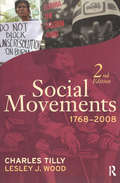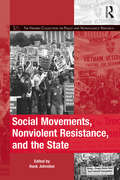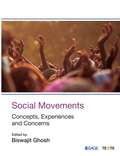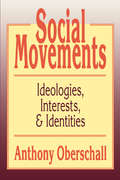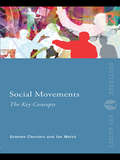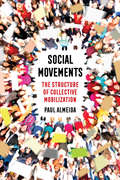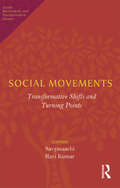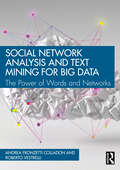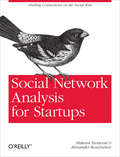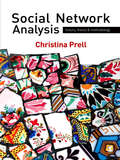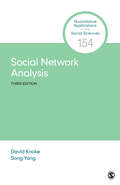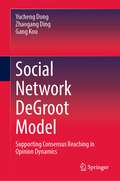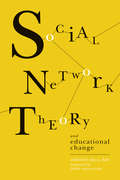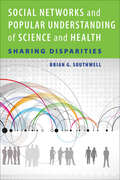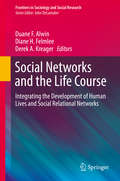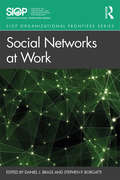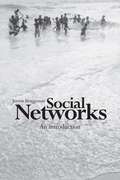- Table View
- List View
Social Movements, 1768-2008
by Charles Tilly Lesley J. WoodThis expanded second edition of Tilly's widely acclaimed 2004 book brings this analytical history of social movements fully up to date. Tilly and Wood cover such recent topics as immigrants' rights, new media technologies, anti-Olympic organizing in China, new mobilizations against the Iraq War, and the role of bloggers and Facebook in social movement activities. Coverage of these and other recent events serve to expand further the book's seminal theorizing and conceptualization of how social movements grew from eighteenth-century Europe to eventually fuel popular movements all over the world.
Social Movements, Nonviolent Resistance, and the State (The Mobilization Series on Social Movements, Protest, and Culture)
by Hank JohnstonThis volume probes the intersections between the fields of social movements and nonviolent resistance. Bringing together a range of studies focusing on protest movements around the world, it explores the overlaps and divergences between the two research concentrations, considering the dimensions of nonviolent strategies in repressive states, the means of studying them, and conditions of success of nonviolent resistance in differing state systems. In setting a new research agenda, it will appeal to scholars in sociology and political science who study social movements and nonviolent protest.
Social Movements: Concepts, Experiences and Concerns
by Biswajit GhoshA comprehensive textbook that deals with the issue of social movements from both theoretical and contextual points of view and analyses major cognitive concerns of social movements across disciplines. In contemporary times, social movements are a matter of everyday discourse among researchers, teachers, planners and politicians, administrators and law-enforcing machineries, social activists and common people alike. The book begins by locating social movements within broad and contemporary social processes. It explains the meaning, basic features, origins and types, and the basic perspectives of social movements. It goes on to deal with the major experiences of nine social movements in India, namely, peasant, tribal, Naxalite, Dalit, working class, women, ethnic, student and youth, and environmental movements. The book also analyses the role of information technology, media, civil society, NGOs and the middle class in the spread and continuation of such movements. The experiences of queer, new religious, and anti-systemic and anti-displacement movements would also help readers understand how globalization has offered new avenues of protest to diverse sections of the population. Key Features: • Analyses the major theoretical concerns of social movements and uses them to analyse specific social movements in India and other parts of the globe • Provides the genealogy, growth and impact of prominent social movements in India and abroad • Includes pedagogically rich content, which closely follows UGC course curriculum guidelines for the subject
Social Movements: Ideologies, Interest, and Identities
by Anthony OberschallMore than any other topic in social science, the study of social movements provides an opportunity to combine social theory with political action. Such study is a key to understanding the motivations, successes, and failures of thousands who aspire to high ideals of justice, but who sometimes aid in perpetuating inhumane political acts and systems. Building upon the past twenty years' developments in theory and research, Social Movements combines original theoretical and methodological approaches with penetrating analyses of contemporary movements from the sixties to the present.Anthony Oberschall argues that social movements are central to contemporary politics in both Western and Third World nations. They are not quaint stepchildren to public policy and social change that disappear as nations modernize. Collective action by the citizenry, spilling beyond the boundaries of routine politics is an integral part of the process of creative destruction that Joseph Schumpeter ascribed to modern capitalism and all dynamic, modern societies.Among the subjects that OberschaU examines in Social Movements are the Civil Rights movement, decline of the New Left, the feminist movement, the New Christian Right, the tobacco control movement, collective violence in U.S. industrial relations, and some comparative historical movements, including the Cultural Revolution in China, the abortive 1968 revolution in Czechoslovakia, political strife in postcolonial Africa, and the sixteenth-century European witch craze.In looking beyond the immediate political circumstances of these social movements, Oberschall points the way to achieving the next major task of social movement theory: a more satisfactory understanding of the dynamics and course of social movements and counter movements and a method of accounting for the outcomes of public controversies. Free of jargon and technical terminology, Social Movements is written for sociologists, political scientists, historians, professionals dea
Social Movements: The Key Concepts (Routledge Key Guides)
by Graeme Chesters Ian WelshSocial Movements: The Key Concepts provides an insightful, contemporary introduction to some of the frequently encountered terms and groups that are central to the study of collective action and social and political activism. Following an A-Z format, the entries defined and discussed are drawn from the following areas: the ‘old’ social movements of the nineteenth century the ‘new’ social movements of the 1960s and 1970s the rise of contemporary ‘network’ movements. Key American, European and global social movements are addressed, with each entry related to contemporary developments and emergent tendencies within the field. Including helpful references for further study, this concise and up-to-date guide is of relevance for those studying a range of disciplines, including sociology, politics, cultural studies and human geography.
Social Movements: The Structure of Collective Mobilization
by Paul AlmeidaSocial Movements cleverly translates the art of collective action and mobilization by excluded groups to facilitate understanding social change from below. Students learn the core components of social movements, the theory and methods used to study them, and the conditions under which they can lead to political and social transformation. This fully class-tested book is the first to be organized along the lines of the major subfields of social movement scholarship—framing, movement emergence, recruitment, and outcomes—to provide comprehensive coverage in a single core text. Features include:use of real data collected in the U.S. and around the worldthe emphasis on student learning outcomescase studies that bring social movements to lifeexamples of cultural repertoires used by movements (flyers, pamphlets, event data on activist websites, illustrations by activist musicians) to mobilize a grouptopics such as immigrant rights, transnational movement for climate justice, Women's Marches, Fight for $15, Occupy Wall Street, Gun Violence, Black Lives Matter, and the mobilization of popular movements in the global South on issues of authoritarian rule and neoliberalism With this book, students deepen their understanding of movement dynamics, methods of investigation, and dominant theoretical perspectives, all while being challenged to consider their own place in relation to social movements.
Social Movements: Transformative Shifts and Turning Points (Social Movements and Transformative Dissent)
by Ravi Kumar SavyasaachiThis volume attempts to show the emerging contours of ‘transformative action’ in social movements across South Asia. It argues that these contours have been shaped by contestations over questions of equity, justice and well-being on the one hand, and the nature and scope of new and classical social movements on the other. This is manifest in diverse modes through people’s struggles, protest and dissent. The authors examine a variety of themes that have determined the course of the politics of transformative struggles. They critique neoliberalism, ‘primitive’ accumulation, money, class inequalities, as well as aspects of capital–labour conflict. They highlight the contributions of movements by women, dalit and marginalized communities; peace movements; and environmental and agrarian struggles. The volume also appraises the role of internet in grassroots mobilizations and that of civil society networks in the making of participatory democracy. It further argues that the predicaments of cultural, ethnic, national, regional, and linguistic identities are not divorced from capital–labour conflicts. The book will serve as essential reading for students and scholars of sociology, social movements, politics, gender and feminist studies, labour studies, and the informed general reader.
Social Myths and Collective Imaginaries
by Howard Scott Gerard Bouchard Les Editions du BorealMyths are commonly associated with illusions or with deceptive, dangerous discourse, and are often perceived as largely the domain of premodern societies. But even in our post-industrial, technologically driven world, myths – Western or Eastern, ancient or modern, religious or scientific – are in fact powerful, pervasive forces. In Social Myths and Collective Imaginaries, Gérard Bouchard conceptualizes myths as vessels of sacred values that transcend the division between primitive and modern. Myths represent key elements of collective imaginaries, past and present. In all societies there are values and beliefs that hold sway over most of the population. Whether they come from religion, political institutions, or other sources, they enjoy exalted status and go largely unchallenged. These myths have the power to bring societies together as well as pull them apart. Yet the study of myth has been largely neglected by sociologists and other social scientists. Bouchard navigates this uncharted territory by addressing a number of fundamental questions: What is the place of myth in contemporary societies and in the relations between the cultural and the social? How do myths take form? From what do they draw their strength? How do they respond to shifting contexts? Myths matter, Bouchard argues, because of the energy they unleash, energy that enables a population to mobilize and rally around collective goals. At the same time myths work to alleviate collective anxiety and to meet the most pressing challenges facing a society. In this bold analysis, Bouchard challenges common assumptions and awakens us to the transcendent power of myth in our daily lives and in our shared aspirations.
Social Network Analysis and Text Mining for Big Data: The Power of Words and Networks
by Andrea Fronzetti Colladon Roberto VestrelliSocial Network Analysis and Text Mining for Big Data presents cutting-edge methods and tools that bridge the gap between text mining and social network analysis research while also providing new insights for analyzing (big) textual and network data. These tools are designed to cater to the needs of both business analysts and researchers to facilitate the creation of groundbreaking analytics.Beginning with clear definitions of social network analysis and text mining, this book benefits from a thoughtfully curated selection of methods and tools, drawn from the authors’ extensive research in the field. The focus then shifts to demonstrate how the interplay between words and networks can unlock the full potential of big data analytics. A centerpiece of the book is the Semantic Brand Score (SBS), a versatile and powerful metric for assessing brand importance through text analysis. All of the above is corroborated and illustrated with practical applications and case studies showing the value of these analytics in supporting change and improved managerial decisions. It also introduces a specialized software tool which enables users to perform the analyses detailed in the text.This book is a must-read for business leaders, marketing professionals, policymakers, researchers, and university students. It offers practical insights and actionable advice for achieving increased performance of companies and societal actions. The writing is tailored to make complex concepts accessible to both experienced researchers and readers who are new to the field.
Social Network Analysis for Startups: Finding connections on the social web
by Alexander Kouznetsov Maksim TsvetovatDoes your startup rely on social network analysis? This concise guide provides a statistical framework to help you identify social processes hidden among the tons of data now available.Social network analysis (SNA) is a discipline that predates Facebook and Twitter by 30 years. Through expert SNA researchers, you'll learn concepts and techniques for recognizing patterns in social media, political groups, companies, cultural trends, and interpersonal networks. You'll also learn how to use Python and other open source tools—such as NetworkX, NumPy, and Matplotlib—to gather, analyze, and visualize social data. This book is the perfect marriage between social network theory and practice, and a valuable source of insight and ideas.Discover how internal social networks affect a company’s ability to performFollow terrorists and revolutionaries through the 1998 Khobar Towers bombing, the 9/11 attacks, and the Egyptian uprisingLearn how a single special-interest group can control the outcome of a national electionExamine relationships between companies through investment networks and shared boards of directorsDelve into the anatomy of cultural fads and trends—offline phenomena often mediated by Twitter and Facebook
Social Network Analysis: History, Theory and Methodology
by Christina PrellWe live in a world that is paradoxically both small and vast; each of us is embedded in local communities and yet we are only a few 'links' away from anyone else in the world. This engaging book represents these interdependencies' positive and negative consequences, their multiple effects and the ways in which a local occurrence in one part of the world can directly affect the rest. Then it demonstrates precisely how these interactions and relationships form. This is a book for the social network novice learning how to study, think about and analyse social networks; the intermediate user, not yet familiar with some of the newer developments in the field; and the teacher looking for a range of exercises, as well as an up-to-date historical account of the field. It is divided into three clear sections: 1. Historical & Background Concepts 2. Levels of Analysis 3. Advances, Extensions and Conclusions The book provides a full overview of the field - historical origins, common theoretical perspectives and frameworks; traditional and current analytical procedures and fundamental mathematical equations needed to get a foothold in the field.
Social Network Analysis: Methods And Examples (Quantitative Applications in the Social Sciences #154)
by David Knoke Song YangDavid Knoke and Song Yang′s Social Network Analysis, Third Edition provides a concise introduction to the concepts and tools of social network analysis. The authors convey key material while at the same time minimizing technical complexities. The examples are simple: sets of 5 or 6 entities such as individuals, positions in a hierarchy, political offices, and nation-states, and the relations between them include friendship, communication, supervision, donations, and trade. The new edition reflects developments and changes in practice over the past decade. The authors also describe important recent developments in network analysis, especially in the fifth chapter. Exponential random graph models (ERGMs) are a prime example: when the second edition was published, P* models were the recommended approach for this, but they have been replaced by ERGMs. Finally, throughout the volume, the authors comment on the challenges and opportunities offered by internet and social media data.
Social Network Analysis: Methods And Examples (Quantitative Applications in the Social Sciences #154)
by David Knoke Song YangDavid Knoke and Song Yang′s Social Network Analysis, Third Edition provides a concise introduction to the concepts and tools of social network analysis. The authors convey key material while at the same time minimizing technical complexities. The examples are simple: sets of 5 or 6 entities such as individuals, positions in a hierarchy, political offices, and nation-states, and the relations between them include friendship, communication, supervision, donations, and trade. The new edition reflects developments and changes in practice over the past decade. The authors also describe important recent developments in network analysis, especially in the fifth chapter. Exponential random graph models (ERGMs) are a prime example: when the second edition was published, P* models were the recommended approach for this, but they have been replaced by ERGMs. Finally, throughout the volume, the authors comment on the challenges and opportunities offered by internet and social media data.
Social Network DeGroot Model: Supporting Consensus Reaching in Opinion Dynamics
by Gang Kou Yucheng Dong Zhaogang DingThis book investigates the DeGroot model in social network contexts, and proposes the social network DeGroot (SNDG) model. Specifically, this book focuses on two core research problems in the SNDG model: (i) Social network structures to reach a stable state (consensus, polarization, or fragmentation); and (ii) the convergence rate to reach a stable state. Furthermore, the authors generalize the SNDG model in an uncertain context, showing the effects of interval opinions on the SNDG model. In this book, the authors also discuss the applications of the SNDG model to support group decision making, including consensus reaching through adding minimum interactions, trust relationships manipulations, and risk control issues in the social network. Apart from theoretical analysis, detailed experimental simulations with real and random data will be applied to validate our research.This book is the first to connect opinion dynamics, social network and group decision making. The resultsreported can help us understand the evolution of public opinions in social network contexts and provide new tools to support consensus reaching in group decision making.
Social Network Theory and Educational Change
by Alan J. DalySocial Network Theory and Educational Change offers a provocative and fascinating exploration of how social networks in schools can impede or facilitate the work of education reform. Drawing on the work of leading scholars, the book comprises a series of studies examining networks among teachers and school leaders, contrasting formal and informal organizational structures, and exploring the mechanisms by which ideas, information, and influence flow from person to person and group to group. The case studies provided in the book reflect a rich variety of approaches and methodologies, showcasing the range and power of this dynamic new mode of analysis. An introductory chapter places social network theory in context and explains the basic tools and concepts, while a concluding chapter points toward new directions in the field. Taken together, they make a powerful statement: that the success or failure of education reform ultimately is not solely the result of technical plans and blueprints, but of the relational ties that support or constrain the pace, depth, and direction of change. This unique volume provides an invaluable introduction to an emerging and increasingly important field of education research.
Social Networks and Health Inequalities: A New Perspective for Research
by Andreas Klärner Markus Gamper Sylvia Keim-Klärner Irene Moor Holger von der Lippe Nico VonneilichThis open access book applies insights from the network perspective in health research to explain the reproduction of health inequalities. It discusses the extant literature in this field that strongly correlates differences in social status with health behaviours and outcomes, and add to this literature by providing a coherent theoretical explanation for the causes of these health inequalities. It also shows that much research is needed on the precise factors and the social and socio-psychological mechanisms that are at play in creating and cementing social inequalities in health behaviours. While social support and social relations have received considerable attention within social and behavioural science research on health inequalities, this book considers the whole network of interpersonal relations, structures and influence mechanisms. This is the perspective of the social network analytical approach which has recently gained much attention in health research. The chapters of this book cover state-of-the-art research, open research questions, and perspectives for future research. The book provides network analyses on health inequalities from the perspective of sociology, psychology, and public health and is of interest to a wide range of scholars, students and practitioners trying to understand how health inequalities are reproduced across generations.
Social Networks and Music Worlds (Routledge Advances in Sociology)
by Nick Crossley Paul Widdop Siobhan McAndrewSocial networks are critical for the creation and consumption of music. This edited collection, Social Networks and Music Worlds, introduces students and scholars of music in society to the core concepts and tools of social network analysis. The collection showcases the use of these tools by sociologists, historians and musicologists, examining a variety of distinct 'music worlds', including post-punk, jazz, rap, folk, classical music, Ladyfest and the world of 'open mic' performances, on a number of different scales (local, national and international). In addition to their overarching Introduction, the editors offer a very clear and detailed introduction to the methodology of social network analysis for the uninitiated. The collection builds upon insights from canonic texts in the sociology of music, with the crucial innovation of examining musical network interaction via formal methods. With network analysis in the arts and humanities at an emergent stage, Social Networks and Music Worlds highlights its possibilities for non-scientists. Contributions hail from leading and emerging scholars who present social network graphs and data to represent different music worlds, locating individuals, resources and styles within them. The collection sits at the nexus of sociological, musicological and cultural studies traditions. Its range should ensure a large scholarly readership.
Social Networks and Popular Understanding of Science and Health: Sharing Disparities
by Brian G. SouthwellA data-driven analysis of how different people share information about health through social media.Using social media and peer-to-peer networks to teach people about science and health may seem like an obvious strategy. Yet recent research suggests that systematic reliance on social networks may be a recipe for inequity. People are not consistently inclined to share information with others around them, and many people are constrained by factors outside of their immediate control. Ironically, the highly social nature of humankind complicates the extent to which we can live in a society united solely by electronic media.Stretching well beyond social media, this book documents disparate tendencies in the ways people learn and share information about health and science. By reviewing a wide array of existing research—ranging from a survey of New Orleans residents in the weeks after Hurricane Katrina to analysis of Twitter posts related to H1N1 to a physician-led communication campaign explaining the benefits of vaginal birth—Brian G. Southwell explains why some types of information are more likely to be shared than others and how some people never get exposed to seemingly widely available information.This book will appeal to social science students and citizens interested in the role of social networks in information diffusion and yet it also serves as a cautionary tale for communication practitioners and policymakers interested in leveraging social ties as an inexpensive method to spread information.
Social Networks and Regional Identity in Bronze Age Italy
by Emma Blake"This book takes an innovative approach to detecting regional groupings in peninsular Italy during the Late Bronze Age, a notoriously murky period of Italian prehistory. Applying social network analysis to the distributions of imports and other distinctive objects, Emma Blake reveals previously unrecognized exchange networks that are in some cases the precursors of the named peoples of the first millennium BC: the Etruscans, the Veneti, and others. In a series of regional case studies, she uses quantitative methods to both reconstruct and analyze the character of these early networks and posits that, through path dependence, the initial structure of the networks played a role in the success or failure of the groups occupying those same regions in later times. This book thus bridges the divide between Italian prehistory and the Classical period, and demonstrates that Italy's regionalism began far earlier than previously thought"--
Social Networks and the Life Course: Integrating The Development Of Human Lives And Social Relational Networks (Frontiers In Sociology And Social Research Ser. #2)
by Duane F. Alwin Diane H. Felmlee Derek A. KreagerThis volume engages the interface between the development of human lives and social relational networks. It focuses on the integration of two subfields of sociology/social science--the life course and social networks. Research practitioners studying social networks typically focus on social structure or social organization, ignoring the complex lives of the people in those networks. At the same time, life course researchers tend to focus on individual lives without necessarily studying the contexts of social relationships in which lives are embedded and “linked” to one another through social networks. These patterns are changing and this book creates an audience of researchers who will better integrate the two subfields. It covers the role of social networks across the life span, from childhood and adolescence, to midlife, through old age.
Social Networks at Work (SIOP Organizational Frontiers Series)
by Stephen P. Borgatti Daniel J. BrassSocial Networks at Work provides the latest thinking, from top-notch experts, on social networks as they apply to industrial and organizational (I/O) psychology. Each chapter provides an in-depth review along with discussions of future research and managerial implications of the social network perspective. Altogether, the volume illustrates the importance of adding a social capital perspective to the traditional human capital focus of I/O psychology. The volume is organized into two groups of chapters: the first seven chapters focus on specific network concepts (such as centrality, affect, negative ties, multiplexity, cognition, and structural holes) applied across a variety of topics. The remaining eight chapters focus on common I/O topics (such as personality, creativity, turnover, careers, person–environment fit, employment, teams, and leadership) and examine each from a network perspective, applying a variety of network concepts to the topic. This volume is suited for students and academics interested in applying a social network perspective to their work, as well as for practicing managers. Each topic area provides a useful review and guide for future research, as well as implications for managerial action.
Social Networks: An Introduction
by Jeroen BruggemanSocial Networks: An Introduction is the first textbook that combines new with still-valuable older methods and theories. Designed to be a core text for graduate (and some undergraduate) courses in a variety of disciplines it is well-suited for everybody who makes a first encounter with the field of social networks, both academics and practitioners. This book includes reviews, study questions and text boxes as well as using innovative pedagogy to explain mathematical models and concepts. Examples ranging from anthropology to organizational sociology and business studies ensure wide applicability. An easy to use software tool, free of charge and open source, is appended on the supporting website that enables readers to depict and analyze networks of their interest. It is essential reading for students in sociology, anthropology, and business studies and can be used as secondary material for courses in economics and political science.
Social Neuroscience and Public Health: Foundations for the Science of Chronic Disease Prevention
by Peter A. HallThe field of public health is primarily concerned with understanding and improving physical health from a large group perspective (i.e., communities and whole populations). The field of social neuroscience, on the other hand, is primarily concerned with examining brain-behavior relationships that unfold in a social context. Both of these are rapidly developing fields of inquiry, and their boundaries have only recently begun to overlap. This book discusses collaborative research findings at the intersection of social neuroscience and public health that promise to fundamentally change the way scientists, public health practitioners, and the general public view physical health within the larger social context. Eighteen chapters are organized under the following major sections: cognition and health outcomes; neuroscientific aspects of health communication; health behavior and the neurobiology of self-regulation; neurobiological processes in health decision making; ecological and social context; neuroscience methods; and future directions.
Social Neuroscience: Biological Approaches to Social Psychology (Frontiers of Social Psychology)
by Eddie Harmon-Jones and Michael InzlichtSocial Neuroscience provides an updated and critically important survey of contemporary social neuroscience research. In response to recent advances in the field, this book speaks to the various ways that basic biological functions shape and underlie social behavior. The book also shows how an understanding of neuroscience, physiology, genetics, and endocrinology can foster a fuller, more consilient understanding of social behavior and of the person. These collected chapters cover traditional and contemporary social psychology topics that have received conceptual and empirical attention from social neuroscience approaches. While the focus of the chapters is demonstrating how social neuroscience methods contribute to understanding social psychological topics, they also cover a wide range of social neuroscience methods, including hormones, functional magnetic resonance imaging, electroencephalography, event-related brain potentials, cardiovascular responses, and genetics.
Social Neuroscience: Key Readings (Key Readings in Social Psychology)
by John T. Cacioppo Gary G. BerntsonNeuroscientists and cognitive scientists have collaborated for more than a decade with the common goal of understanding how the mind works. These collaborations have helped unravel puzzles of the mind including aspects of perception, imagery, attention and memory. Many aspects of the mind, however, require a more comprehensive approach to reveal the mystery of mind-brain connections. Attraction, altruism, speech recognition, affiliation, attachment, attitudes, identification, kin recognition, cooperation, competition, empathy, sexuality, communication, dominance, persuasion, obedience, morality, contagion, nurturance, violence, and person memory are just a few. Through classic and contemporary articles and reviews, Social Neuroscience illustrates the complementary nature of social, cognitive, and biological levels of analysis and how research integrating these levels can foster more comprehensive theories of the mechanisms underlying complex behaviour and the mind.
